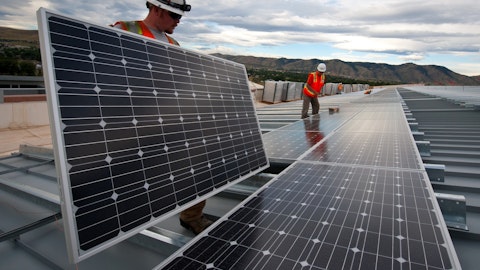Nipul Patel: Great. Now, that doesn’t have to do with dilution. We’re not planning to draw on the preferred at this point. What that really means there, if you recall, we had drawn a bit of the preferred at the beginning of the year. So, you’ve got the full year impact of that in there. And then we will make an assessment each quarter on kind of what the lowest cost of capital is when we decide to accrue the dividends and pay down the term loan instead based on the variable rate we have on our term loan. So, that’s really the reason why you see a little bit higher in the preferred for 2020 — for 2023.
Philip Shen: Okay. Thanks very much, Nipul. I’ll pass it on. Unless there’s something else you guys want to share.
Nipul Patel: Thank you.
Operator: Thank you. Our next question comes from Mark Strouse with JPMorgan. Please state your question.
Unidentified Analyst: Hi, good afternoon. It’s Drew on for Mark. Thanks for taking our questions. Just want to touch on the new products quickly. Can you just talk a little bit about what the H250 and OmniTrack are seeing from a market receptivity standpoint and how that’s translating into orders and then what’s kind of the timing outlook for future shipments?
Erica Brinker: Hi, this is Erica. I’m happy to speak to it. So, from a product perspective, what we’re trying to address the customers are each of their individual needs project-by-project. So, we want to take a consultative approach, meaning depending on their site topography, wind speeds, we have a product that addresses those needs. So, DuraTrack has been our flagship product for several years. And with that, we have the related OmniTrack, which is terrain following, so that it opens up a lot more land possibilities than ever before without touching the actual terrain and it also takes into account environmental factors because you’re not having to move any dirt. When we talked about the H250, that’s allowing us to have more flexibility if you have uneven boundaries in your land.
And sometimes the 32 rows work and sometimes the two rows design — the dual row design with H250 is a much better fit for customers. And so what we’re doing is opening up the addressable market that we — in the way that we partner with our customers.
Unidentified Analyst: Okay, great. Thank you.
Erica Brinker: And I’ll just say I’ll just say from a customer point of view for them if the demand is very great when you talk about not having to — when you can shorten lead-times by not moving land and leveraging our OmniTrack product, we are hearing from customers that they can’t get it soon enough. So, we’re excited to be able to have three products at our disposal. And just one other thing that I like to mention, with all of those products, our intent is to ensure that SmarTrack, our software runs across all of our tracker lines, so that our customers can have that consistency in the software delivery and productivity of their site.
Unidentified Analyst: Okay. And then just kind of a follow-up on that. Any thoughts on when shipments might be starting? And then also is that having any impact on why pricing might be somewhat flat and not increasing in 2023?
Kevin Hostetler: Let me address the pricing thing here. So, first of all, as many of you understood, steel had been coming down quite a bit up until about the last three weeks. We were on this deflationary pathway and we were having opposite conversations with analysts of, hey, do you have to reduce price because steel is demonstrably lower than it was last year. Now, steel has been reversing for the last three to four weeks. It’s creeping back up. And we’re taking a kind of a conservative approach at that because it’s changing so quickly. So, again, we’re protected the way we do our business. We’re protected from a margin perspective on steel, but it certainly does have an impact in the overall price. And so what we see is this, as we’ve modeled out fairly flat, you’ve got a combination of things, you’ve got a combination of steel and aluminum, being at lower rates than they were at this time of last year, offset with the more difficult type of sites that require additional engineering and additional content to be able to make those sites work effectively.
So, that’s really what’s driving that — our current view of flat. What we haven’t baked in, as Nipul said, not only haven’t we baked in any impact of the IRA in terms of the overall manufacturing credits, but we also haven’t baked in any potential impact from our — what we believe is the best in class domestic supply chain, right? As you would expect to go forward and depending upon final nature of the domestic content clarification, we could see some additional pricing power yet in the back half of the year just due to that strength, we haven’t domestic content to customers who will have to pay a premium for a higher percentage of domestic content if they want to get that extra 10% kicker. So, what we’ve done is just taken again as usual what you’ve seen with our team is a conservative view of that pricing at this point.
And as we get additional information, as we understand further where commodities are going, both steel and aluminum in particular, we’ll come back to the market and update on what we think our ASPs can do in the back half of the year.



